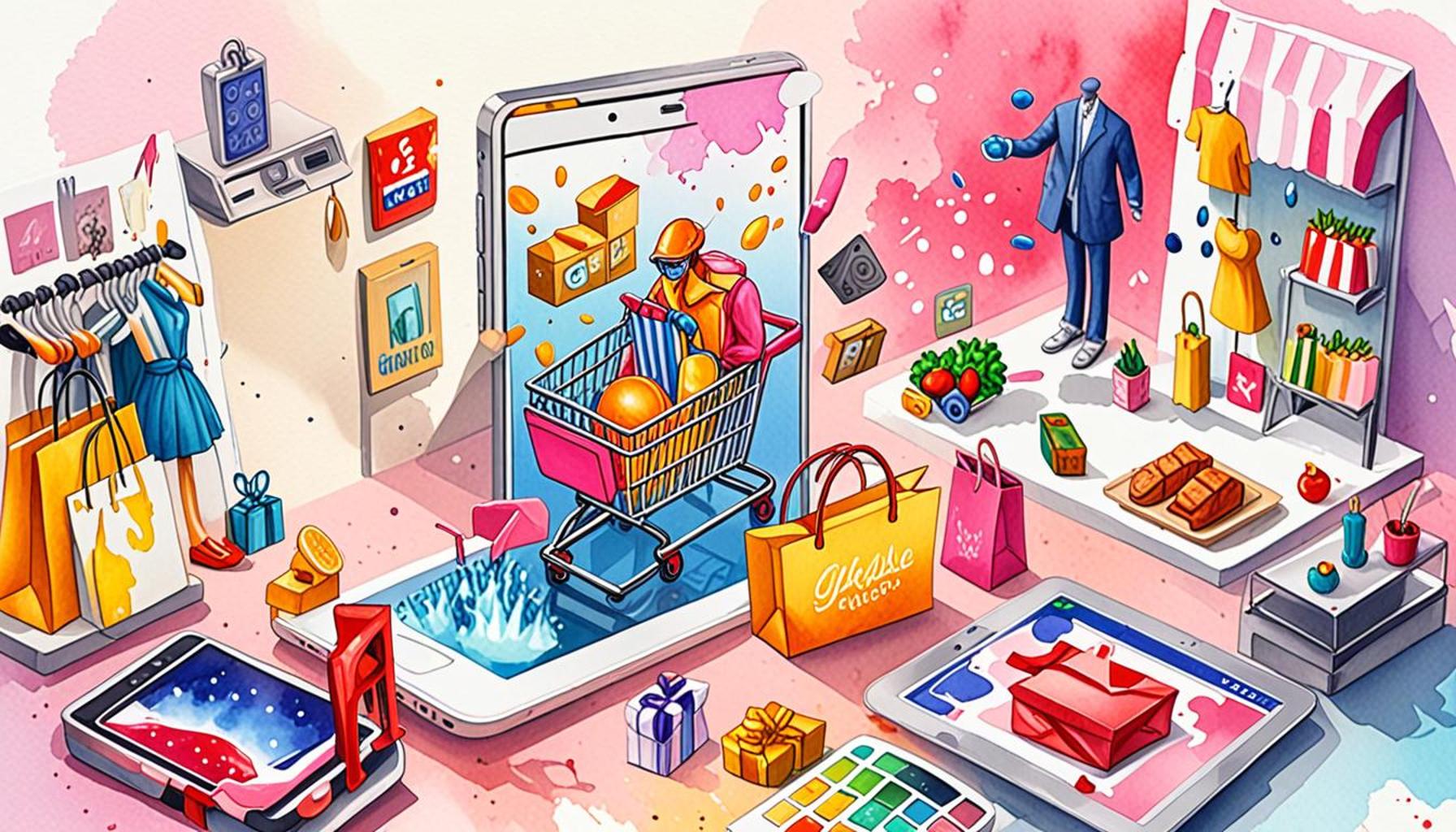The Role of Augmented Reality in Shopping Experiences and Its Impact on Consumer Finances

Understanding Augmented Reality in Retail
Augmented Reality (AR) has fundamentally transformed the shopping landscape, enhancing the way consumers interact with products and brands. Through the integration of digital elements into the physical environment, AR provides an immersive experience that reshapes decision-making processes. As a result, this technology not only affects consumer behavior but also has significant implications for personal finances.
The benefits of AR in retail include:
- Enhanced Product Visualization: Customers can see how products look and fit in their environment before making a purchase. For example, furniture retailers like IKEA have developed AR applications that allow consumers to visualize how a piece of furniture would fit in their home. This capability empowers shoppers to make more confident decisions and reduces the uncertainty often associated with online shopping.
- Informed Decision-Making: By virtually trying on clothes or testing furniture, consumers can reduce the likelihood of returns. Companies such as Warby Parker offer virtual try-on features that allow customers to see how different eyeglass frames look on their faces, minimizing the inconvenience of returns due to sizing or style mismatches.
- Increased Engagement: Interactive shopping experiences captivate customers, leading to longer shopping sessions and higher spending. Retailers leveraging AR technologies—such as Sephora’s AR makeup app—are able to enrich customer interactions by allowing them to experiment with different makeup looks virtually before making a purchase.
However, the impact of AR extends beyond user experience; it can also influence financial outcomes. Key financial implications include:
- Reduction in Return Rates: Fewer returns can lead to cost savings for retailers and enhanced consumer satisfaction. According to industry studies, retailers that implement AR solutions see a significant decrease in return rates, thereby optimizing inventory and reducing logistics costs, which can translate into savings that may be passed on to consumers.
- Altered Spending Habits: The enticing nature of AR could lead to impulsive buying, impacting budget adherence. As AR makes shopping more enjoyable and immersive, it may inadvertently encourage consumers to spend more than originally intended. Marketing strategists warn that consumers must remain vigilant in maintaining their budgets when engaging with these captivating experiences.
- Access to Deals: AR applications often feature promotions that can encourage smarter financial decisions if utilized wisely. Retailers can tailor AR experiences that highlight special offers, creating a sense of excitement and urgency for consumers to take advantage of these deals, such as exclusive discounts triggered through AR interactions in-store.
In this article, we will explore the multifaceted role of AR in shopping experiences and examine how it shapes consumer finances in the United States. By delving into the benefits and financial implications of augmented reality in retail, we can better understand how this innovative technology influences both consumer behavior and the broader economic landscape.
DISCOVER MORE: Click here to learn about the economic impact of e-commerce growth
Augmented Reality’s Influence on Consumer Behavior
Augmented Reality (AR) is not merely a technological phenomenon; it has catalyzed a dramatic shift in consumer behavior within the retail sector. By blending digital information with the physical shopping experience, AR enhances the engagement level of consumers, directly influencing their purchasing decisions and, ultimately, their financial outcomes. Understanding how AR impacts shopping experiences is critical for both retailers and consumers aiming to navigate the complexities of modern buying behaviors.
One of the most significant manifestations of AR’s influence is the enhancement in product contemplation. Consumers are increasingly appreciating the ability to visualize products in their own environment before making a purchase. This is particularly evident in home décor and fashion sectors, where visual representation can dramatically alter purchasing decisions. A study by Deloitte indicated that consumers who engage with AR technology while shopping are 70% more likely to make a purchase compared to those who do not utilize such features. This statistic underscores the power of AR in driving sales while fostering an informed purchase process.
The incorporation of AR into shopping also fosters a sense of personalization. Consumers can experience tailored recommendations and product changes that align specifically with individual preferences or previous shopping behaviors. Retailers can leverage data analytics and AR technologies to offer customized shopping experiences, thus enhancing customer satisfaction. For instance, beauty retailers like L’Oreal have implemented AR-based applications that enable users to try on various shades of lipstick virtually. Such personalized features not only cater to consumer preferences but also enhance sales conversions, reflecting positively on retailers’ bottom lines.
Financial Implications of Enhanced Consumer Engagement
The financial implications of these enhanced shopping experiences are noteworthy. The direct correlation between increased sales and AR functionalities suggests that retailers could see substantial growth in revenue. However, this technology also brings about a shift in consumer financial behaviors that warrant careful consideration:
- Investment in Smart Technologies: Retailers are increasingly investing in AR technologies to stay competitive. This monetary commitment can lead to short-term financial strain but may yield long-term returns through increased sales and customer retention.
- Cognitive Overload: The immersive nature of AR can lead to cognitive overload, where consumers may struggle to evaluate their purchasing choices fully. This phenomenon can result in overstimulation, potentially prompting consumers to make impulsive purchases that deviate from their original budgets.
- Evaluation of Cost-Benefit: While AR enhances consumer engagement, it also necessitates a critical evaluation of cost versus benefit from a consumer perspective. Ensuring accountability in spending means consumers must weigh the excitement AR generates against their existing financial commitments and goals.
As the integration of AR in retail continues to advance, the relationship between enhanced shopping experiences and consumer finances will become increasingly intertwined. It is essential for consumers to remain aware of the potential financial implications of engaging with AR technologies while shopping, enabling them to make informed decisions that align with their financial health.
DISCOVER MORE: Click here to learn about the advantages of renewable energy investments
The Challenges Presented by Augmented Reality in Consumer Spending
While Augmented Reality (AR) offers profound advantages in enhancing consumer experiences, it equally poses challenges that can adversely affect consumer finances. Understanding these pitfalls is crucial for consumers as they navigate AR-enabled shopping platforms. The intersection of enhanced visualization and purchasing impulsivity highlights the necessity for informed financial decision-making.
One critical challenge stemming from AR integration is the potential for overconsumption. The ability to see a product “in action” can create a compelling urge to purchase items that consumers may not typically consider or need. For instance, furniture retailers utilizing AR allow customers to place digital representations of sofas or tables in their living rooms, leading to a heightened desire for aesthetics and functionality that may not align with initial budgetary considerations. A report from the National Retail Federation indicated that consumers exposed to AR experiences were 20% more likely to overspend, driven primarily by emotional responses catalyzed by immersive technology.
An additional concern is the impact of AR on consumer awareness regarding product pricing. With striking visual experiences, consumers may focus primarily on the perceived value of the product rather than its actual cost. Retailers can leverage this shortcoming by presenting AR-enhanced products that communicate desirability through immersive imagery rather than transparent pricing structures. Without adequate consideration of financial implications, consumers may inadvertently prioritize instant gratification over long-term financial goals.
AR’s Role in Consumer Education and Budgeting
Conversely, AR has the potential to play a positive role in consumer education regarding budgeting and financial awareness. Retailers can design AR applications that promote smarter shopping habits, such as integrating financial planning tools that would help consumers set budgets before entering the AR shopping experience. For example, an AR app could allow users to input their financial limits and subsequently highlight products that fall within these constraints, thus facilitating more responsible spending habits.
Furthermore, through increased informational offerings, AR can equip consumers with necessary insights into cost-per-use analyses, helping them understand the long-term value of expensive purchases. Retailers like IKEA have begun integrating such calculations into their AR apps, providing consumers with data on the durability and average lifespan of products in a format easily digestible through AR viewing. Such insights can pave the way for more sustainable purchasing patterns, aligning consumer choices with financial planning.
- Potential for Price Comparisons: AR can facilitate side-by-side comparisons of similar products from various retailers, enhancing price transparency and allowing consumers to make informed financial decisions.
- Gamification Elements: Retailers can incorporate elements of gamification into AR experiences, rewarding consumers for making informed choices or adhering to spending limits, thus promoting both engagement and financial responsibility.
- Encouraging Reflection: AR experiences can be designed to prompt consumers to reflect on their purchasing intentions before completing transactions, potentially mitigating impulsive buying behaviors.
As AR continues to evolve in the shopping landscape, both consumers and retailers must consider the financial ramifications of this technology. Understanding these dynamics will be crucial for fostering a balanced shopping environment where engagement does not come at the cost of financial stability.
DISCOVER MORE: Click here to learn about the impact of remote work
Conclusion
In summary, Augmented Reality (AR) has emerged as a transformative force in the shopping industry, revolutionizing how consumers engage with products and brands. Its capacity to provide immersive experiences enhances product visualization and fosters a deeper emotional connection, ultimately shaping consumer perceptions and purchasing behaviors. However, the integration of AR comes with significant implications for consumer finances. The potential for overconsumption and diminished awareness of pricing can lead to impulsive buying, thereby jeopardizing financial stability.
Despite these challenges, AR also presents opportunities for positive consumer education and responsible spending. By utilizing AR technology to promote budgeting tools, facilitate price comparisons, and stimulate reflection on purchasing decisions, retailers can empower consumers to make informed choices that align with their financial goals. Initiatives that incorporate gamification and cost-per-use analyses can further enhance consumer engagement while fostering financial responsibility.
The importance of understanding the dual impact of AR on shopping experiences cannot be overstated. As consumers navigate this evolving landscape, a proactive approach towards financial literacy and conscious spending will be imperative. Both consumers and retailers must prioritize a balanced understanding of the advantages and potential pitfalls of AR technology. By embracing a holistic view, the retail industry can cultivate a shopping environment that supports both innovation and financial well-being, ultimately contributing to more sustainable consumer behaviors in the long term.









